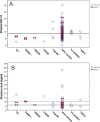New advances in DPYD genotype and risk of severe toxicity under capecitabine
- PMID: 28481884
- PMCID: PMC5421769
- DOI: 10.1371/journal.pone.0175998
New advances in DPYD genotype and risk of severe toxicity under capecitabine
Abstract
Background: Deficiency in dihydropyrimidine dehydrogenase (DPD) enzyme is the main cause of severe and lethal fluoropyrimidine-related toxicity. Various approaches have been developed for DPD-deficiency screening, including DPYD genotyping and phenotyping. The goal of this prospective observational study was to perform exhaustive exome DPYD sequencing and to examine relationships between DPYD variants and toxicity in advanced breast cancer patients receiving capecitabine.
Methods: Two-hundred forty-three patients were analysed (88.5% capecitabine monotherapy). Grade 3 and grade 4 capecitabine-related digestive and/or neurologic and/or hemato-toxicities were observed in 10.3% and 2.1% of patients, respectively. DPYD exome, along with flanking intronic regions 3'UTR and 5'UTR, were sequenced on MiSeq Illumina. DPD phenotype was assessed by pre-treatment plasma uracil (U) and dihydrouracil (UH2) measurement.
Results: Among the 48 SNPs identified, 19 were located in coding regions, including 3 novel variations, each observed in a single patient (among which, F100L and A26T, both pathogenic in silico). Combined analysis of deleterious variants *2A, I560S (*13) and D949V showed significant association with grade 3-4 toxicity (sensitivity 16.7%, positive predictive value (PPV) 71.4%, relative risk (RR) 6.7, p<0.001) but not with grade 4 toxicity. Considering additional deleterious coding variants D342G, S492L, R592W and F100L increased the sensitivity to 26.7% for grade 3-4 toxicity (PPV 72.7%, RR 7.6, p<0.001), and was significantly associated with grade 4 toxicity (sensitivity 60%, PPV 27.3%, RR 31.4, p = 0.001), suggesting the clinical relevance of extended targeted DPYD genotyping. As compared to extended genotype, combining genotyping (7 variants) and phenotyping (U>16 ng/ml) did not substantially increase the sensitivity, while impairing PPV and RR.
Conclusions: Exploring an extended set of deleterious DPYD variants improves the performance of DPYD genotyping for predicting both grade 3-4 and grade 4 toxicities (digestive and/or neurologic and/or hematotoxicities) related to capecitabine, as compared to conventional genotyping restricted to consensual variants *2A, *13 and D949V.
Conflict of interest statement
Figures



References
-
- Beck A, Etienne MC, Chéradame S, Fischel JL, Formento P, Renée N, et al. A role for dihydropyrimidine dehydrogenase and thymidylate synthase in tumour sensitivity to fluorouracil. Eur J Cancer. 1994;30A(10):1517–22. - PubMed
-
- Nishimura M, Naito S. Tissue-specific mRNA expression profiles of human phase I metabolizing enzymes except for cytochrome P450 and phase II metabolizing enzymes. Drug Metab Pharmacokinet. 2006;21(5):357–74. - PubMed
-
- Fleming RA, Milano G, Thyss A, Etienne MC, Renée N, Schneider M, et al. Correlation between dihydropyrimidine dehydrogenase activity in peripheral mononuclear cells and systemic clearance of fluorouracil in cancer patients. Cancer Res. 1992;52(10):2899–902. - PubMed
-
- van Kuilenburg AB. Dihydropyrimidine dehydrogenase and the efficacy and toxicity of 5-fluorouracil. Eur J Cancer. 2004;40(7):939–50. doi: 10.1016/j.ejca.2003.12.004 - DOI - PubMed
-
- Magné N, Etienne-Grimaldi MC, Cals L, Renée N, Formento JL, Francoual M, et al. Dihydropyrimidine dehydrogenase activity and the IVS14+1G>A mutation in patients developing 5FU-related toxicity. Br J Clin Pharmacol. 2007;64(2):237–40. PubMed Central PMCID: PMC2000632. doi: 10.1111/j.1365-2125.2007.02869.x - DOI - PMC - PubMed
Publication types
MeSH terms
Substances
LinkOut - more resources
Full Text Sources
Other Literature Sources
Molecular Biology Databases
Research Materials

